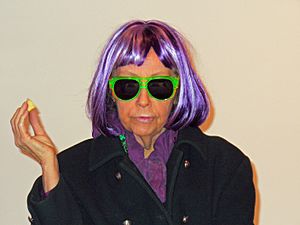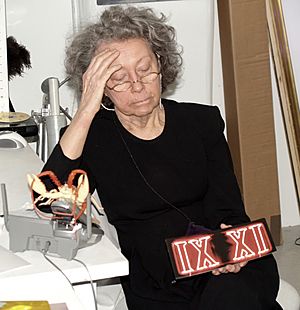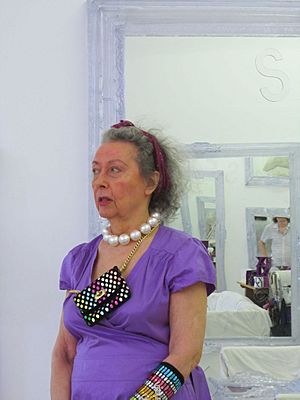Isabelle Collin Dufresne facts for kids
Quick facts for kids
Isabelle Collin Dufresne
|
|
|---|---|

Ultra Violet, 1970
|
|
| Born | 6 September 1935 La Tronche, France
|
| Died | 14 June 2014 (aged 78) New York City, US
|
| Other names | Ultra Violet |
| Occupation | Actress, writer, artist |
Isabelle Collin Dufresne (born September 6, 1935 – died June 14, 2014) was a French-American artist and writer. She was best known by her stage name, Ultra Violet. She worked closely with the famous artist Andy Warhol and was one of his "Superstars." Earlier in her career, she also worked with the surrealist artist Salvador Dalí. Ultra Violet lived and created art in New York City and also had a studio in Nice, France.
Contents
Early Life and Art
Isabelle Collin Dufresne grew up in a strict, well-off family. However, she was very rebellious from a young age. She attended a Catholic school and later a reform school. In 1953, she earned a degree in Art from Le Sacré Cœur in Grenoble, France. Soon after, she left France to live with her older sister in New York City.
Meeting Salvador Dalí
In 1954, Isabelle met the famous artist Salvador Dalí. She became his "muse" (someone who inspires an artist) and worked as his assistant in his studios. She helped him both in Port Lligat, Spain, and in New York City. She later remembered, "I realized that I was 'surreal,' which I never knew until I met Dalí." In the 1960s, Dufresne became interested in the new American Pop Art movement. This art style included artists like Jasper Johns, Robert Rauschenberg, and James Rosenquist.
Working with Andy Warhol

In 1963, Salvador Dalí introduced Isabelle Dufresne to Andy Warhol at a hotel in New York. Soon, she joined Warhol's unusual art studio, known as "The Factory." In 1964, Warhol suggested she choose a stage name. She picked "Ultra Violet" because she often dyed her hair violet or lilac. She became one of Warhol's many "superstars." These were people who appeared in his films and became famous through their connection to him. Ultra Violet acted in more than a dozen of Warhol's films between 1965 and 1974.
Films and Later Work
In 1969, Ultra Violet starred in a film called The Secret Life of Hernando Cortez. It was filmed in Mexico. She appeared in more than 20 films in total, not counting many documentaries made at The Factory.
During the 1970s and 1980s, Ultra Violet slowly moved away from The Factory scene. She took on a quieter role and focused on creating her own art. In 1988, she published her autobiography, Famous for 15 Minutes: My Years with Andy Warhol. This book shared stories about many of Warhol's superstars.
Later Career as an Artist
After her book was reviewed by The New York Times, it was published around the world in 17 different languages. After touring for her book, she returned to France. In 1990, she opened an art studio in Nice and wrote another book about her own ideas on art, called L'Ultratique. She continued to live and work as an artist in New York City and also kept her studio in Nice for the rest of her life.
Exhibitions and Documentaries
In 2000, Ultra Violet was featured in a documentary called Message to Andy Warhol. In 2005, she joined a discussion about Salvador Dalí at the Philadelphia Museum of Art. She shared her memories with another artist who had worked with Dalí, Amanda Lear.
In 2006, she had her own art show at the Stefan Stux Gallery in Chelsea, Manhattan. In 2010, a short documentary called Ultra Violet for Sixteen Minutes was released. It showed her thoughts on fame, art, religion, and her current art projects.
In 2014, Ultra Violet showed her art in four different exhibitions in New York and Nice. Her last exhibition in Manhattan, Ultra Violet: The Studio Recreated, closed just three weeks before she passed away. This show included her paintings, sculptures, photographs, films, and neon art. Three of her sculptures are now part of the permanent collection at the 9/11 Museum.
Personal Life
Isabelle Collin Dufresne passed away on June 14, 2014, in New York City. She was 78 years old and died from cancer. She never married. She is buried in Saint-Égrève, near Grenoble, France.
See also
 In Spanish: Isabelle Collin Dufresne para niños
In Spanish: Isabelle Collin Dufresne para niños



